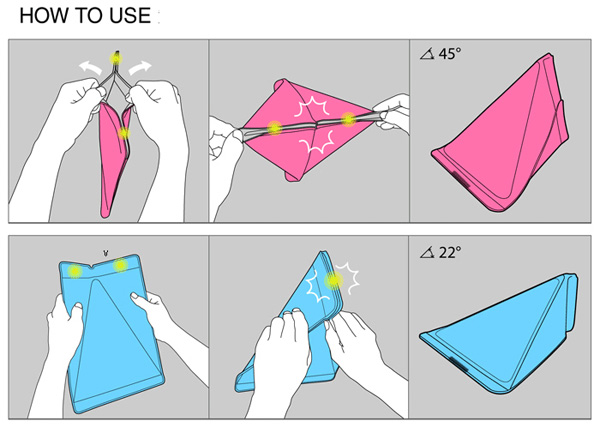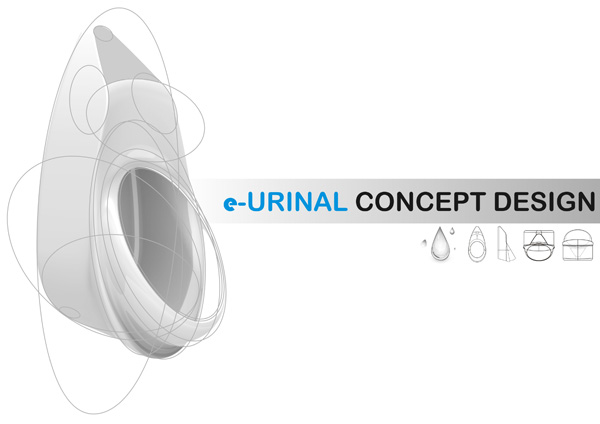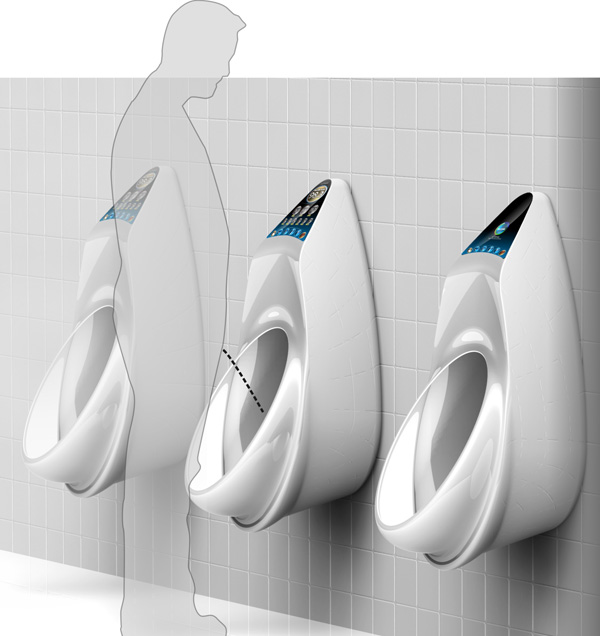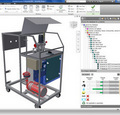Smarty iPad Cover
by: Yanko Design, 2012-01-06 08:02:00 UTC
As a proud iPad owner, I am disappointed to say I have yet to find a cover that I really love. I’m a purist at heart (and maybe even a little picky), so I like to hold the bare iPad & feel the aluminum back & overall thinness. The Smart Stand Sleeve is probably the closest thing I’ll find to what I want. It uses an ingenious folding technique & magnets to transform the case from a soft, protecting sleeve (that isn’t bound to the iPad) into an angled stand for working or watching videos.
Designers: Kim Jung-Sik, Cho Jae-Hong, Lim Sung-Won, Koo Bon-Young, Lee Bum-Joon & Shin Jung-Won




----------
Yanko Design
Timeless Designs - Explore wonderful concepts from around the world!
Yanko Design Store - We are about more than just concepts. See what's hot at the YD Store!
(Smarty iPad Cover was originally posted on Yanko Design)
MOCO'11: Step aside solar panels, the future is microbe powered
by: mocoloco, 2012-01-05 18:48:35 UTC

In the fictional Back To The Future movie series Doc Brown invents a time travel machine powered by a fusion generator that uses garbage as fuel. Last October Netherlands-based giant Philips showed us the Microbial Home, an integrated cyclical ecosystem where each household function's output is another's input - all powered by waste. The future may actually be garbage powered after all.


 Prototype system removes air pollutants and generates heat for livestock barns
Prototype system removes air pollutants and generates heat for livestock barns
by: Gizmag Emerging Technology Magazine, 2012-01-06 02:20:21 UTC

If you’ve ever so much as stepped into a chicken or swine barn, you’ll know that they can be very, very smelly places. When vented outdoors, the air from these buildings does more than just make the area stink – it can actually be a major source of air pollution and greenhouse gases. Fortunately, however, researchers from North Carolina State University and West Virginia University have created a system that not only helps clean the air going out of the barns, but it heats up the air coming in from outside...
Continue Reading
Prototype system removes air pollutants and generates heat for livestock barnsSection: Research WatchTags: Agriculture,
Air Purification System,
Animals,
Filter,
Heat,
Pollution
Related Articles:


 New material shown to remove CO2 from smokestack effluent and other sources
New material shown to remove CO2 from smokestack effluent and other sources
by: Gizmag Emerging Technology Magazine, 2012-01-06 06:17:42 UTC

In recent years, worries over global climate change caused by excess atmospheric carbon dioxide have led to a number of technologies all aimed at the same thing – capturing human-generated CO2 at the source. These have included the use of things such as
edible sponges,
molten salts and
bacteria, to name just a few. Now, a group of scientists are claiming success with a process that has achieved “some of the highest carbon dioxide removal rates ever reported for humid air” ... and it uses a common and inexpensive polymer...
Continue Reading
New material shown to remove CO2 from smokestack effluent and other sourcesSection: ecoGizmoTags: Air Purification System,
Carbon Sequestration,
Climate Change,
Pollution
Related Articles:


 How Biochar Will Help Kenya Go Green And Save Money
How Biochar Will Help Kenya Go Green And Save Money
by: fast company, 2012-01-04 18:43:22 UTC

Re:char is a pioneering company that sells kilns to farmers in Kenya that allow them to convert their farm waste into what's known as biochar, which can then be used for cooking. As an enterprise, Re:char seeks to deliver a "triple bottom line," expanding the uses of sustainable alternatives for energy, providing a cost-effective solution for farmers in an effort to combat poverty, and stemming deforestation in Africa by encouraging use of biochar as cooking fuel instead of cutting down trees for firewood. Jason Aramburu, the CEO of re:char who works in Bungoma, in the Western Province of Kenya, spoke to us about the emerging area of biochar and a grant that re:char just received from the Gates Foundation to develop a system to transform human waste into biochar.
Fast Company: Where did you get the idea for re:char?
Jason Aramburu: I was doing due diligence for a clean energy investor in New York. After the 2008 financial crisis, the investor I was working for was hit hard. He didn't show up for work for a week, when he came back, it was obvious that he was negatively impacted by the crisis. He ultimately decided to slow down his operations. As I thought about what I wanted to do next, I reflected back on an experience I had had in college, I had participated in a program in Panama at the Smithsonian Tropical Research Institute where I worked on a variety of different projects involving soil and nutrient cycling. I'd heard about biochar there. After the crash, I thought it was time to try something new, and re:char began.
What exactly is biochar?
In the Amazon basin for over 3,000 years indigenous farmers have been making charcoal and burying it in the ground. They did this because it improved the soil's ability to capture and retain nutrients, which led to increased crop yields. The soil is so fertile, that they call these sites terra preta, which means black earth in Portuguese. What the farmers didn't know 3,000 years ago was that biochar was actually making a lasting impact on the soil. Today at the sites where they buried the biochar, it's still in the ground. As a result of how fertile the land is, that biochar-rich land is worth about five times as much as the land without it.
 Are a lot of people working with biochar today?
Are a lot of people working with biochar today?
It's still very new. There are just a handful of companies targeting different ends of the supply chain. Some companies are trying to build multimillion-dollar plants to produce biochar. Those have been slow to develop because the cost is very high and the technology is pretty complex. Our focus is more on the small localized level. This is still very much a frontier.
It sounds like biochar could play a role in play in the global energy crisis.
I don't think there's any silver bullet in renewable and sustainable energy. There's never going to be one technology that solves all of our energy challenges. Biochar is unique because it's the only energy source that is actually "carbon negative." Even under the best scenario, solar energy is only carbon neutral, if you fully account for all the emissions associated with producing and distributing solar panels. When you look at the reality of climate science, carbon neutral is not enough. Biochar is carbon negative, which means that every ton of biochar produced represents carbon extracted from the air, which cannot get back into the atmosphere.
How have you built a business around biochar?
In Kenya, we produce and sell a device called a rutuba kiln. In Kiswahili, "rutuba" means soil fertility. The kiln costs us $25-30 to produce and we sell it to a farmer for less than the cost of two bags of fertilizer. Most farmers in a year purchase 2-3 bags of fertilizer and that's typically the largest single purchase that they make. We make the kilns out of repurposed oil barrels in "mobile factories." In places like rural Africa, it's really hard to import and transport finished goods efficiently, so we decided to take a 20-foot shipping container and turn it into a rutuba kiln factory. We outfitted a container with advanced metal fabrication tools in the U.S. and shipped it to Kenya. That container is now our production shop, which allows us to produce kilns locally. This model is scalable. We can deliver factories anywhere in the world that a shipping container can go. We go after 1-2 acre farmers who are farming sugar cane and maize, which means they are earning, on average, $300-600 a year. But much of their production is sold by them directly in the marketplace, which means they are not just farmers but small-business people. They can purchase the kiln outright or they can pay for it over time. The farmer takes the kiln and uses the waste they are producing--things like sugar cane waste, corn cobs, leaves, and stalks--and converts the waste into biochar. Then the farmer can take apply the biochar directly to his field to make it more fertile, or take the biochar and turn it into charcoal briquettes which they can use as fuel to cook food. We find that it only takes the farmer about six months to reap the savings from the briquettes and the increased crop yield necessary to pay for the kiln.
How hard is it to get buy-in from the farmers? I'd imagine many of them would be skeptical.
It's tricky. Especially in Kenya, a lot of these farmers have seen lots of Western ideas come and go. At first we struggled a bit getting farmers on board and getting them to believe that biochar worked. Then we started working with an NGO in the area that is focused on sustainability. They brought us to western Kenya and effectively became our ambassadors and sales team. We've also developed test sites around the area where we can show farmers that biochar works. Now we're setting up a demonstration farm, which will have several different test plots. The farm will allow us to experiment with different kinds of biochar blends. We hope it will become the biochar center for Kenya.
What are some of the new things you are doing?
We just got a grant from the Gates Foundation to test the conversion of human waste into biochar. Sanitation is a big issue in East Africa. So we're working with a company building clean toilets to test converting the output of their toilets into biochar. We already know that this works quite well, it makes a very effective fertilizer. We've already done a lot of the initial testing. We're the only people working in this area right now. It's really a goldmine of feedstock to make biochar. Human waste has the optimal ratio of carbon to nitrogen to grow the crops that humans eat. If you think about it that makes a lot of sense. It's said that early humans discovered agriculture after they realized that certain plants grew well in their own waste.
Note: This interview has been edited for content, clarity, and length.
Read more Fast Talk
David D. Burstein is a young entrepreneur, having completed his first documentary 18 in '08. He is also the Founder & Executive director of the youth voter engagement not for profit, Generation18. His book about the millennial generation will be published by Beacon Press in 2012.


 What’s Your Pee Telling You?!
What’s Your Pee Telling You?!
by: Yanko Design, 2012-01-05 08:02:33 UTC
There’s no denying it! We’ve all monitored our urine’s day to day qualities and wondered what it’s telling us! It’s smart to do so. The E-Urinal is a concept that will finally tell you. It measures PH, SG, URO, BLO, WBC, PRO, GLI, BIL, & KET (basically: sugar levels, PH, red/white blood cells, etc.) all while you pee! Just let it rip and check out your health score on the easy touch screen! Just remember to wash your hands…
We wanna know- would YOU use this in public? At home? Why or why not?
Designer: Royce Zhang





----------
Yanko Design
Timeless Designs - Explore wonderful concepts from around the world!
Yanko Design Store - We are about more than just concepts. See what's hot at the YD Store!
(What’s Your Pee Telling You?! was originally posted on Yanko Design)
Bottom-Up Innovations that Change How IT Does Sustainability
by: Greener Design, 2012-01-04 12:45:11 UTC
Kickstarter -- and some of the cutting-edge inventions that are breaking records on the crowdfunding site -- are helping to change how green IT comes to market, and speeding the arrival of the Internet of Things.

 Logos Decagon: the infinitely extendable modular tent
Logos Decagon: the infinitely extendable modular tent
by: Gizmag Emerging Technology Magazine, 2012-01-04 18:22:55 UTC

The Decagon Link Station is a modular tent system by Japanese camping firm Logos. The various tents, canopies and tunnels of the Decagon range can be selected and connected as needed for a bespoke tent tailored to the specific needs of the user. Campsite etiquette notwithstanding, there's no theoretical limit to the size and complexity of the final assembly...
Continue Reading
Logos Decagon: the infinitely extendable modular tentSection: OutdoorsTags: Camping,
Modular,
Tent
Related Articles:


 Lit Motors' C-1 electric motorcycle will stand up for itself
Lit Motors' C-1 electric motorcycle will stand up for itself
by: Gizmag Emerging Technology Magazine, 2012-01-04 23:58:59 UTC

As any avid biker will tell you, motorcycles have a lot of advantages over cars - they use less fuel, accelerate faster, are more maneuverable, can be parked in more places, and don't incorporate the weight of extra seating for passengers who are non-existent on solo commutes. As many
other people will tell you, however, motorcycles also leave their occupants open to the rain and cold, and can potentially tip over and scatter those occupants across the road. That's where Lit Motors' C-1 comes into the picture. It's a proposed fully-enclosed two-passenger electric motorbike that uses an electronically-controlled gyroscopic stabilizing system to stay upright when stopped, or even when struck from the side in an accident...
Continue Reading
Lit Motors' C-1 electric motorcycle will stand up for itselfSection: MotorcyclesTags: Electric Motorcycle,
Gyro,
KERS,
Self-balancing
Related Articles:


 Volvo to unveil XC60 Plug-in Hybrid Concept car in Detroit
Volvo to unveil XC60 Plug-in Hybrid Concept car in Detroit
by: Gizmag Emerging Technology Magazine, 2012-01-05 05:14:54 UTC

The
North American International Auto Show (NAIAS) 2012, which kicks off in Detroit next Monday, will see Volvo unveil its XC60 Plug-in Hybrid Concept car that it describes as “an electric car, a highly economical hybrid and a powerful high-performance car all rolled into one.” At the press of a button, the XC60 Plug-in Hybrid Concept can switch between Pure electric mode, Hybrid mode, or Power mode, which combines the power of the 280 hp gasoline engine with the 70 hp electric motor to propel the car from zero to 60 mph (96.5 km/h) in 5.8 seconds...
Continue Reading
Volvo to unveil XC60 Plug-in Hybrid Concept car in DetroitSection: AutomotiveTags: Concept Cars,
NAIAS 2012,
Plug-in Hybrid,
Volvo
Related Articles:













Comments by our Users
Be the first to write a comment for this item.